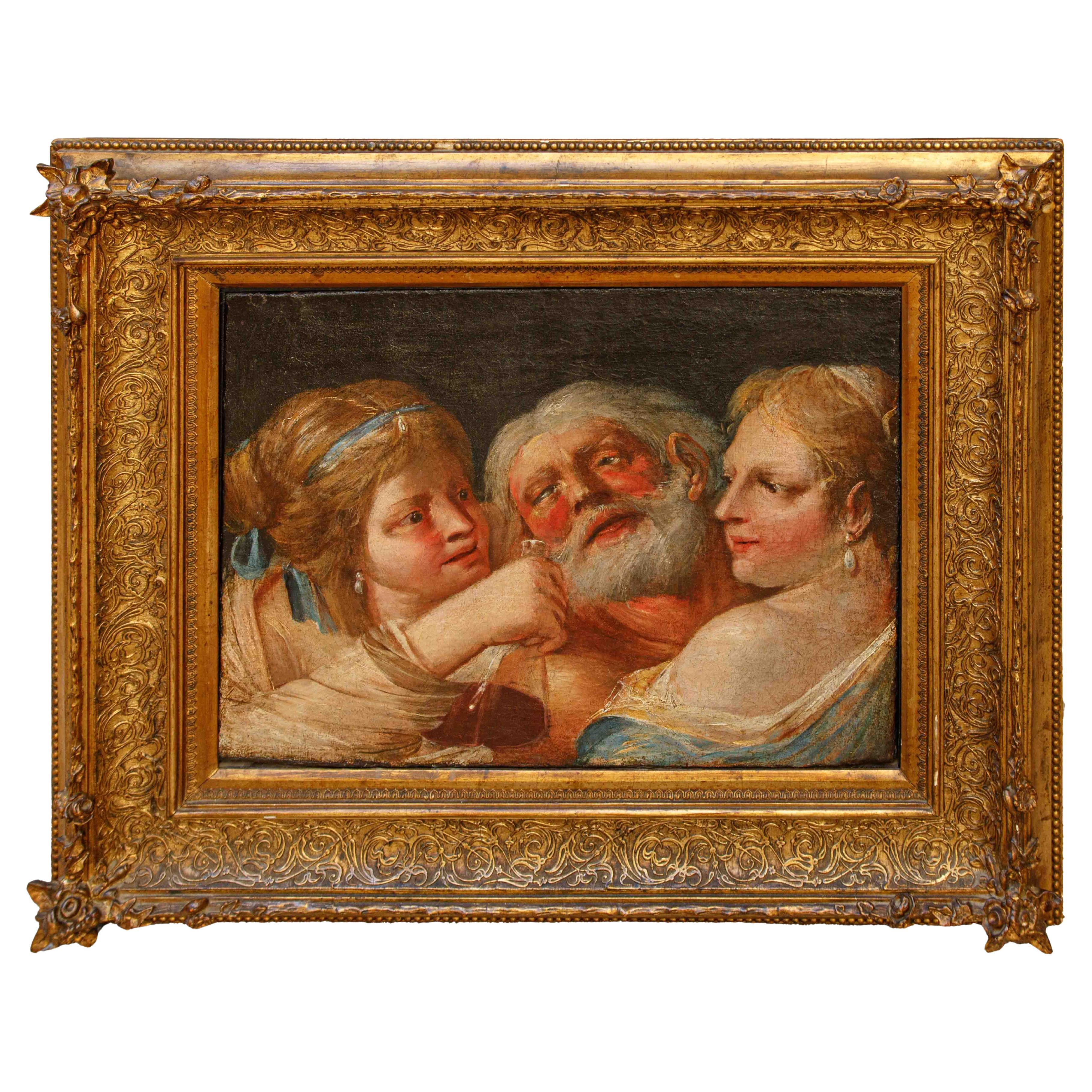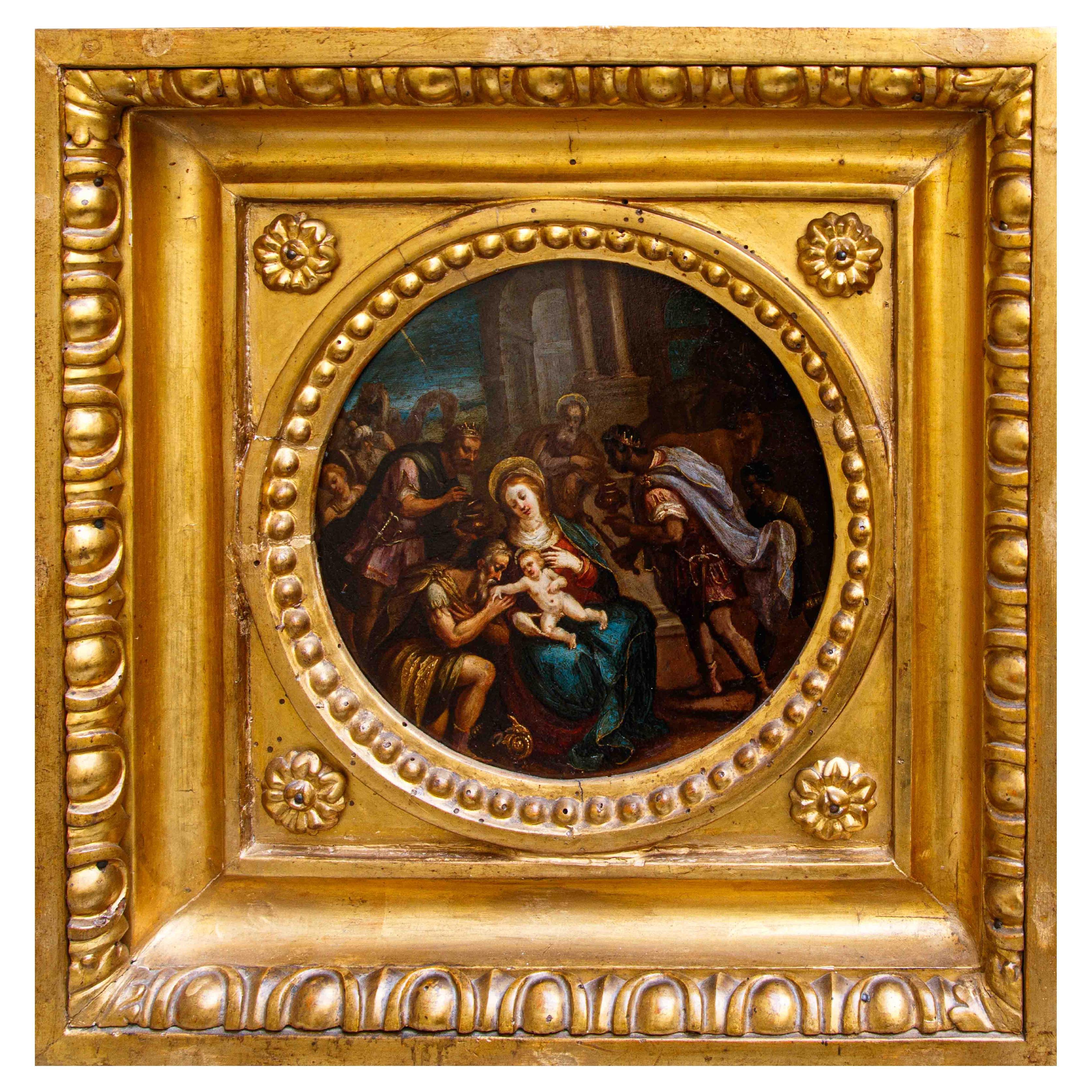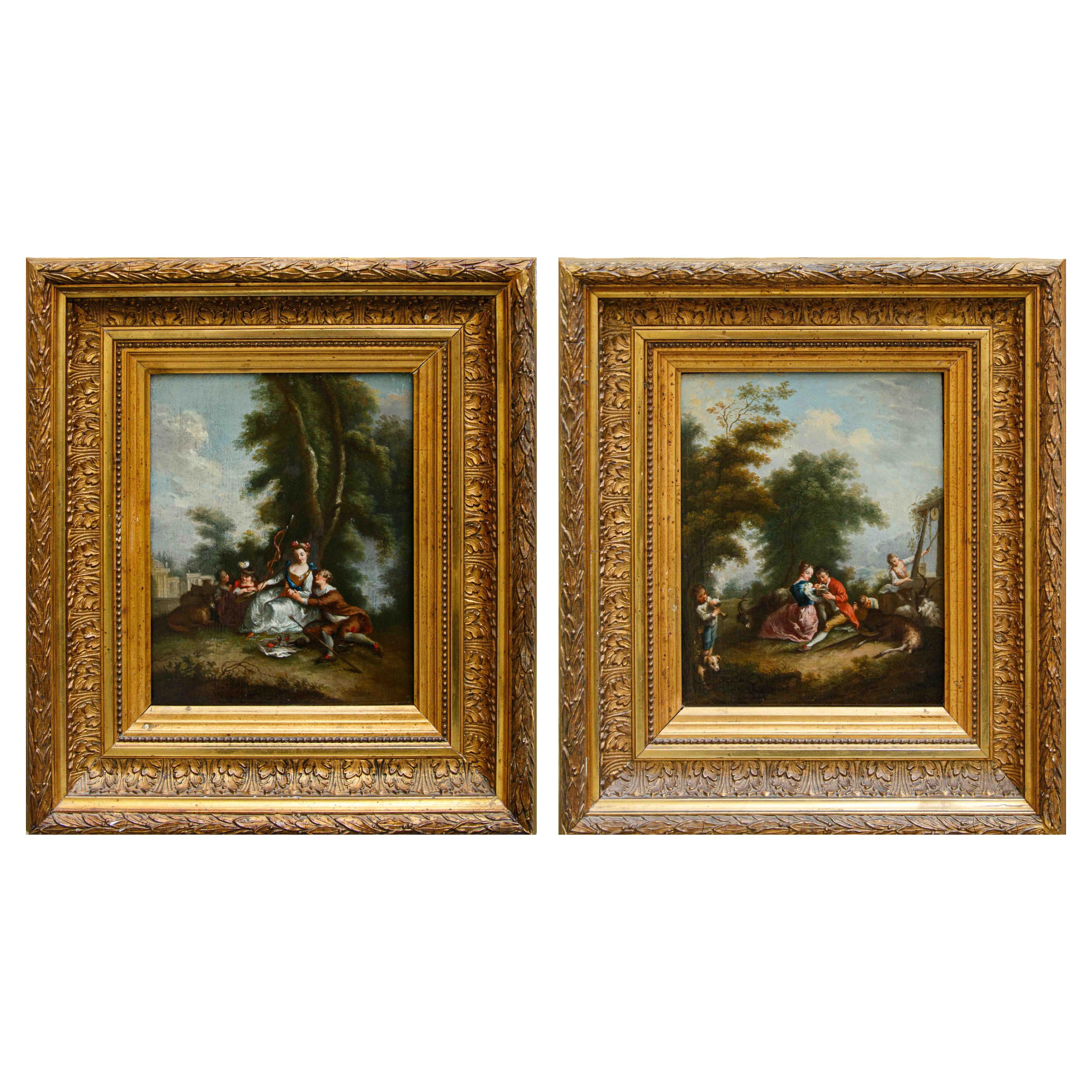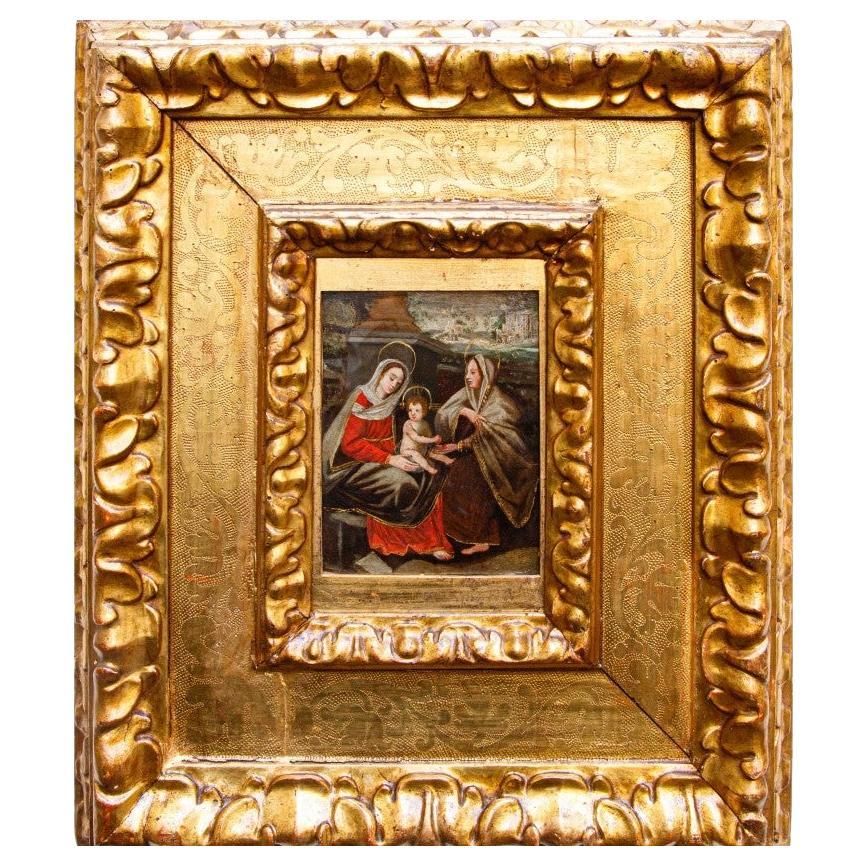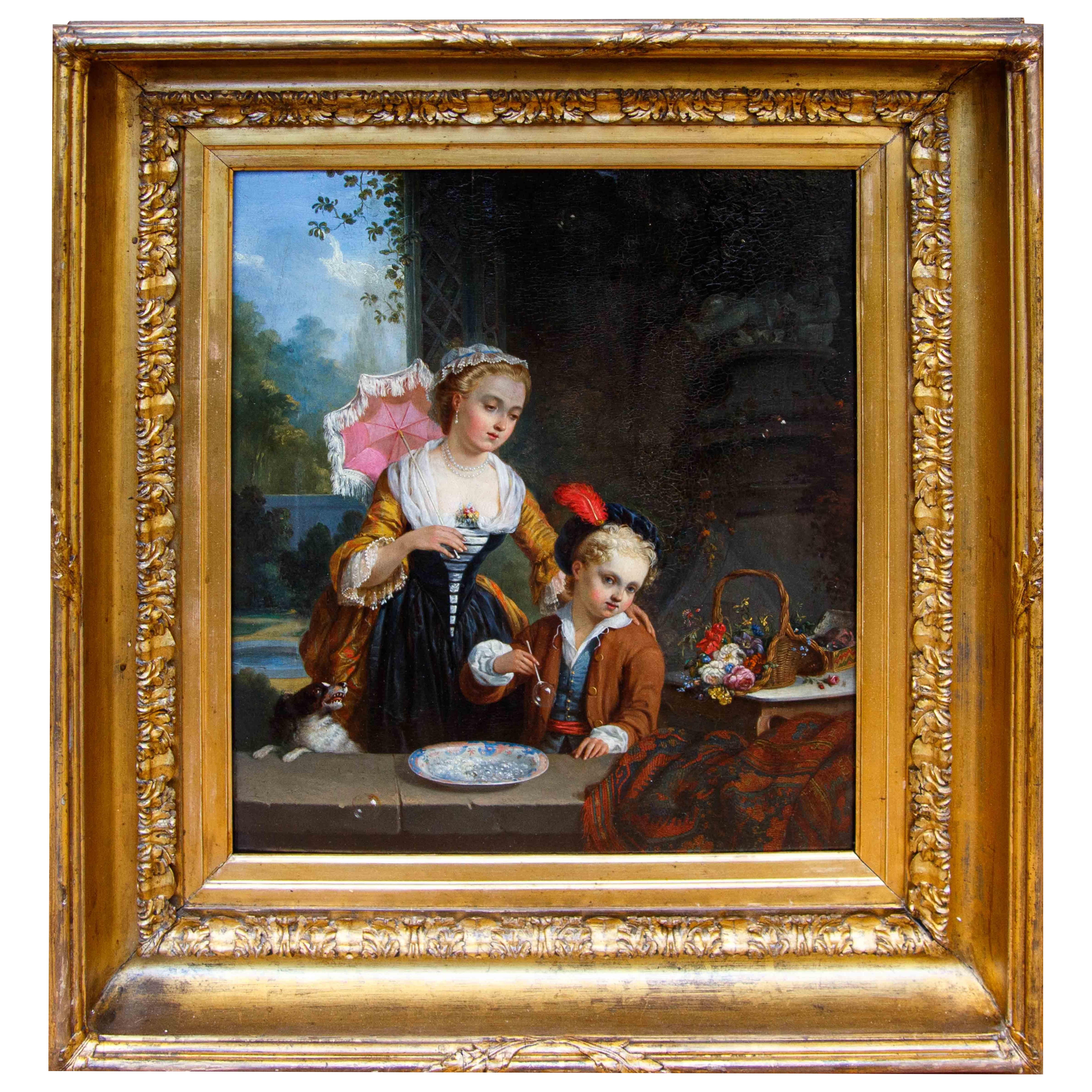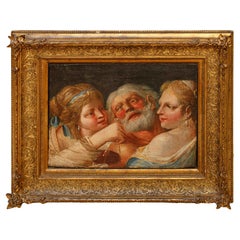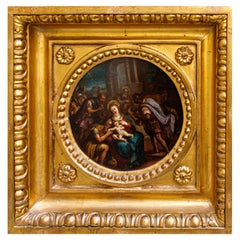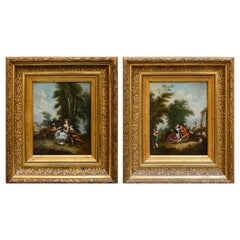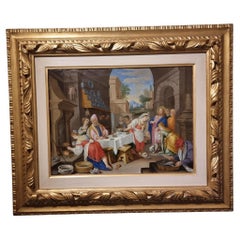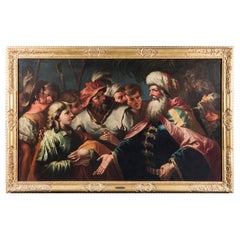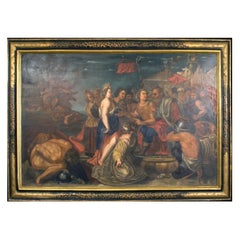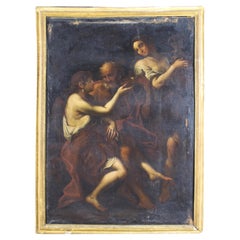Items Similar to Venetian school, Tobias and Sara in Nineveh, oil on canvas, 16th century
Want more images or videos?
Request additional images or videos from the seller
1 of 14
Venetian school, Tobias and Sara in Nineveh, oil on canvas, 16th century
$5,927.98
£4,436.45
€5,000
CA$8,178.16
A$9,094.46
CHF 4,776.61
MX$111,188.85
NOK 59,521.08
SEK 56,112.30
DKK 38,062.48
About the Item
Venetian School, second half of the 16th century
Tobiah and Sarah led to Nineveh by the archangel Azariah
Oil on canvas, 48 x 56 cm - Framed, 58 x 72 cm
The present canvas, made with precious chromatics and skillful strokes, can be linked to Venetian production in the second half of the 16th century. The subject of the painting is probably taken from the Bible. The episode in question refers to the story of Sarah, daughter of Raguele, who was the victim of a demon in love, Asmodeus, who whenever she married killed her husband on her wedding night. She prays to God to save her from people's slander. Prayers cause God to send Tobiah from Nineveh to Ecbatana where Sarah resides, to marry her. Tobiah makes his journey together with Azariah, an archangel, who, however, comes in the guise of an experienced traveler. It is he who advises Tobiah to extract the gall, liver and heart from a fish, caught along a river where the two had found rest from their long journey, and to store it in a bag. When Sarah and Tobiah meet, they understand that their meeting is the result of God's will. Father Raguele blesses the bride and groom and invites the servants to prepare the bridal chamber but also to dig a grave for superstition. Tobiah, however, under the Angel's advice before joining his bride, burns the gall, liver and heart of the fish in a brazier. The foul smell emanating from the brazier drives away the demon Asmodeus, who will never return. The young newlyweds, the next day depart for Nineveh laden with animals, servants and other riches donated by Raguele, still accompanied by Azariah, who reveals himself to be the Archangel Raphael once they arrive in Nineveh and after advising Tobiah to sprinkle gall on the eyes of Tobiah's father, who regains his sight.
The painted scene shows Tobiah and Sarah, newlyweds, being escorted to Nineveh by the Angel who is originally filmed with his back turned, with the index fingers of both hands pointed to show the way to the newlyweds, who look at each other in love. The main group is accompanied by animals, a servant and some pottery, (of Venetian and particularly Bassanesque memory) that is, the gifts given to the bride and groom by Raguele. The human figures are shot at half-length, and the painter lacks perspective depth, placing the group of bride and groom and the angel on a higher level and the shepherd/servant with animals on the lower one. In the background is a glimpse of the course of a river, reminiscent of the place from which Tobiah fishes to extract the elements that will save him from the devil.
The story depicted there is rather rare in the history of art, which sees for the most part other Tobias stories, such as Tobias and the Angel, Tobias Fishing for Fish, or the marriage of Tobias and Sarah.
The item is in good condition
- Dimensions:Height: 72 in (182.88 cm)Width: 58 in (147.32 cm)Depth: 3 in (7.62 cm)
- Materials and Techniques:Canvas,Oiled
- Period:
- Date of Manufacture:unfamiliar
- Condition:
- Seller Location:Milan, IT
- Reference Number:1stDibs: LU5918238967352
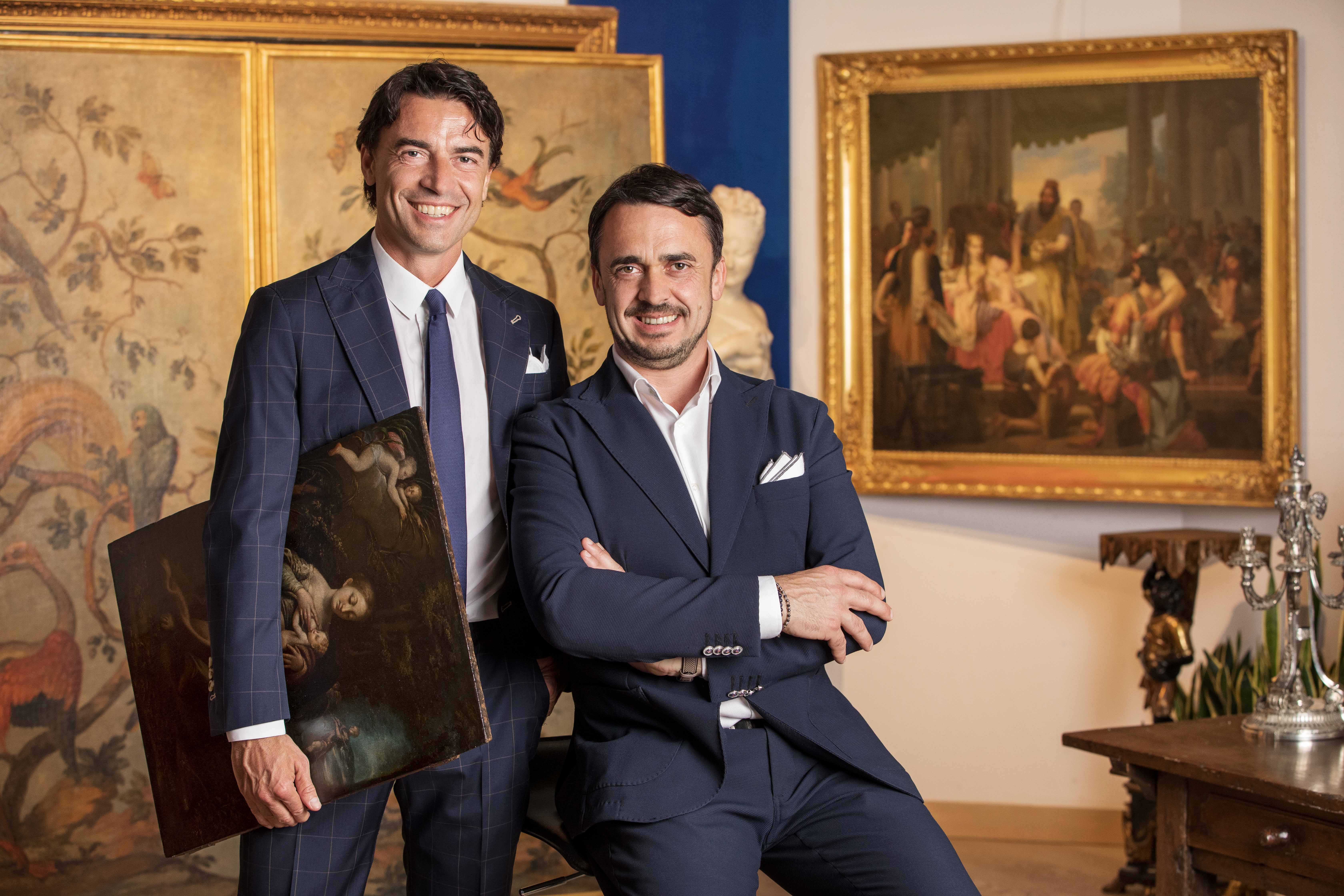
About the Seller
5.0
Vetted Professional Seller
Every seller passes strict standards for authenticity and reliability
Established in 2000
1stDibs seller since 2021
30 sales on 1stDibs
Typical response time: 1 to 2 days
- ShippingRetrieving quote...Shipping from: Milan, Italy
- Return Policy
Authenticity Guarantee
In the unlikely event there’s an issue with an item’s authenticity, contact us within 1 year for a full refund. DetailsMoney-Back Guarantee
If your item is not as described, is damaged in transit, or does not arrive, contact us within 7 days for a full refund. Details24-Hour Cancellation
You have a 24-hour grace period in which to reconsider your purchase, with no questions asked.Vetted Professional Sellers
Our world-class sellers must adhere to strict standards for service and quality, maintaining the integrity of our listings.Price-Match Guarantee
If you find that a seller listed the same item for a lower price elsewhere, we’ll match it.Trusted Global Delivery
Our best-in-class carrier network provides specialized shipping options worldwide, including custom delivery.More From This Seller
View All17th century, Emilian school, Rural landscape with gallant scenes
Located in Milan, IT
17th century, Emilian school
Rural landscape with gallant scenes
Oil on canvas, 37 x 47.5 cm
Framed, 61 x 50.5 cm
The bucolic amenity of the present is reflected within the joyo...
Category
Antique 18th Century and Earlier Italian Other Paintings
Materials
Canvas
Venetian school, mid-18th century, Loth and daughters
Located in Milan, IT
Venetian school, mid-18th century
Loth and the daughters
Oil on canvas, 43 x 57 cm
Framed, 70 x 84 cm
The canvas under consideration clearly depicts Loth and his daughters, the p...
Category
Antique 18th Century and Earlier Italian Other Paintings
Materials
Canvas
17th century, Flemish School, Adoration of the Magi
Located in Milan, IT
17th century, Flemish School
Adoration of the Magi
Oil on copper, diam. 19.5 cm
Framed 35.3 x 35.3 cm
Engraved on the back in seventeenth-century calligraphy "Fiamingo"
Vivid wo...
Category
Antique 18th Century and Earlier Dutch Other Paintings
Materials
Copper
18th century, French School, Gallant scenes
Located in Milan, IT
18th century, French School
Gallant Scenes
(2) Oil on panel, 24 x 19 cm
Framed, 44 x 36 cm
This pair of works attributable to the artistic context of the French eighteenth centu...
Category
Antique 18th Century and Earlier Italian Other Paintings
Materials
Wood
Flemish school, 16th century, St. Anne, the Virgin and Child
Located in Milan, IT
Flemish school, 16th century
St. Anne, the Virgin and Child
Oil on copper, 21 x 16 cm
With period frame, 65 x 56 cm
The painting depicts three central figures: the Madonna, Baby ...
Category
Antique 18th Century and Earlier Belgian Other Paintings
Materials
Copper
18th-19th century, French school, the soap bubbles
Located in Milan, IT
French school, 18th-19th century
The soap bubbles
Oil on panel, 44.5 x 36.5 cm
Framed, 60 x 54 cm
In this French school painting, with its leery and playful tone, but mother lovi...
Category
Antique 19th Century Other Paintings
Materials
Canvas
You May Also Like
Oil on copper 800 Christ in the house of Martha with Mary and Lazarus
By A. Manzoni
Located in Villa Verucchio, Emilia-Romagna
Oil on copper 800 Christ in the house of Martha with Mary and Lazarus - A work of rare beauty
The 1800 oil on copper Christ in Martha's House with Mary and Lazarus is an extraordina...
Category
Antique Mid-19th Century Italian Renaissance Paintings
Materials
Copper
Gaspare Diziani, Joseph sold to Putifares
By Gaspare Diziani
Located in Milano, IT
The work depicts the famous episode in which Joseph, one of Jacob's twelve sons, is sold by his brothers to Putiphar, head of the guards of the king of Egypt.
Diziani became famous ...
Category
Antique 18th Century Italian Paintings
Materials
Canvas
Large historical painting 18th century, Italian school
Located in Cesena, FC
Large historical painting 18th century, Italian school
"Darius' mother pleading before Alexander after the battle of Issus."
Oil on canvas 210 x 290 cm
Painted with great strength...
Category
Antique Late 18th Century Italian Paintings
Materials
Canvas, Wood, Giltwood
Italian 13th century oil on canvas painting "Lot and Daughters"
Located in Cesena, FC
Lot and his daughters, EMILIAN SCHOOL
XVIIIth century
Oil on canvas 175 x 126 cm
Lot and his daughters is one of the themes most frequently encountered by seventeenth-century pain...
Category
Antique 18th Century Italian Baroque Paintings
Materials
Canvas, Paint
18th Biblical Oil on Canvas Pietro della Vecchia Aka Pietro Muttoni
By Pietro della Vecchia
Located in Marseille, FR
Oil on canvas Italian 18th century represents biblical scene: the beheading of St. Jean Baptist and the gift of his head to Salome. Obviously Caravagesque this painting is assigned t...
Category
Antique 18th Century French Baroque Paintings
Materials
Canvas
17th Century, Italian Painting by Pier Francesco Cittadini, Jacob and his Family
Located in IT
Pier Francesco Cittadini (Milan, 1616-Bologna, 1681)
"Jacob and his family go to Egypt"
Oil on canvas, cm 109 x 190 (canvas only)
The valuable painting, made in oil on canvas, depicts Jacob and his family go to Egypt and we believe it can be, given the high quality painting, autograph work of Italian Pier Francesco Cittadini (Italy Milan, 1616 - Bologna, 1681) made after 1647. The work, in excellent condition is accompanied by a coeval frame in wood finely carved and golden.
The scene depicted, which was confused with the Flight to Egypt in the past years, is instead identified with the biblical episode of Jacob’s journey. In the foreground, reading the painting from left to right, we see a caravan composed of animals, including donkeys, dromedaries, goats, dogs and horses and people, women, men and slaves, who carry on their journey along the banks of a river, following a path that to the right, would seem to lead to the through of a bridge. In addition to the watercourse is described an environment characterized by large rocks and impervious come far to cover the entire verticality of the canvas. On the left, in the distance, we see the tail of the caravan that runs along the steep path. Large trees enliven and harmonize the environment, as well as white and grey clouds characterize the predominantly clear sky and illuminated on the right by sunlight.
The story is told in the Bible, Book of Genesis, 30, 25, passage in which is described the flight of Jacob from Haran after the contrasts with Laban, father of his wife Rachel. Jacob is the third great patriarch of the Bible. From his descendants originate the twelve generations of the people of Israel. He is the son of Isaac and Rebekah, who led him to flee from the wrath of Esau to Haran to seek refuge from his brother, Laban. At his uncle’s house Jacob met his daughter Rachel. As soon as he saw his cousin, Jacob was taken. Jacob will stay seven years in the service of Laban to marry his beloved Rachel. But Laban, with a deception, will give him in marriage first Lia, the least beautiful eldest daughter, and only after another seven years the splendid Rachel. From his first wife he will have several children, while Rachel will give birth to the beloved son, Joseph, who will become viceroy of Egypt.
After years of service, Jacob asked to be paid with every dark-coloured garment among the sheep and every spotted and dotted garment among the goats. Laban accepted and sent away from his sons all the leaders of that kind. So Jacob took fresh branches of poplar, almond and plane tree, and flayed them, and put them in the troughs. The optical suggestion induced the goats and the sheep to conceive and give birth to dark, striped and dotted garments. He also ensured that all the strongest and healthiest leaders of the flock of Laban would drink near the barked branches, thus assuring a genetic superiority to his part of the flock. His flocks grew numerous and strong and he became richer than his relative, arousing envy. It was clear that Laban would not respect him much longer. At the suggestion of the Lord, Jacob decided to return to Canaan. Trying to avoid any possible dispute, he left with his family while Laban was absent for shearing sheep. But when, three days later, his uncle returned home, he became angry, feeling offended because Jacob had gone secretly and had not allowed him to greet his daughters and grandchildren. In addition, his teraphim, statuettes, or idols, which depicted the family deities, had disappeared. After 7 days of pursuit, Laban and his men reached Jacob’s group on Mount Gilead, in the mountainous region west of the Euphrates River, where his uncle and grandson had a stormy conversation. The younger man was outraged at being accused of stealing idols and told Labano to rummage through his family’s tents at will. Neither of them could know or even imagine that it was Rachel who took the idols and hid them in the saddle of the camel. During the search, she sat down firmly on the saddle, apologizing for not being able to get up, «because I usually have what happens to women» (Gen 31:35). So the loot wasn’t discovered.
The author of this work was inspired by the composition of an engraving by Stefano Della Bella (1610-1664) of circa 1647. The engraving by Stefano della Bella bears the title "Iacob sur ses vieux jours quitte sans fascherie pour voir son filz Ioseph, sa terre et sa patrie" and is signed on the bottom left "Stef. of the Beautiful In. et fe." while on the right it is declared "Cum privil. Regis", that is with license of the king.
Stefano Della Bella (Italy - Florence, May 18, 1610-Florence, July 12, 1664) was born in a family of painters, sculptors and goldsmiths and was left early orphan of his father sculptor, he dedicated himself first to the art of goldsmith at the school of Giovanni Benedetto Castiglione and Gasparo Mola, then turning his attention to drawing and engraving. He soon began drawing figures and copying the etchings of Jacques Callot, which inspired his early works. Under the protection of the Medici, in particular of Don Lorenzo, cadet son of Grand Duke Ferdinand I, Della Bella has the opportunity to make study trips to Rome, where he stayed from 1633-1636; In Rome he met French engravers and publishers of prints such as Israël Henriet and François Langlois, who influenced his decision to move to Paris in 1639, four years after the death of Callot. In Paris he soon reached, thanks to the engravings commissioned by Cardinal Richelieu, the success also worldly; he frequented courtiers, theatre artists and writers, while refusing too oppressive honors. In 1646-1647 he continued his travels in the Netherlands to Amsterdam, Antwerp and Dordrecht. He returned to Florence in 1650 and resumed working under the protection of the Medici court, working for his patrons. In 1656 he became a member of the Academy of Apatists.
The painting object of this study is reasonably attributable to Pier Francesco Cittadini, or Pierfrancesco Cittadini, called the Milanese or the Franceschino (Italy - Milan, 1616-Bologna, 1681) as some exemplary stylistic comparisons proposed to follow can prove.
Pier Francesco Cittadini was an Italian baroque painter, mainly active in Bologna.
His artistic training first took place with the painter Daniele Crespi...
Category
Antique Mid-17th Century European Baroque Paintings
Materials
Canvas, Giltwood
More Ways To Browse
Napoleon China
Old Japanese Pots
Pagoda Drawers
Painted Hanging Shelves
Red Squirrel
Roman Bed
Rosewood Mother Of Pearl Inlay
Scottish Regency
Simple Oak Bed
Small Metal Figurine
Spindle Bed
Steam Locomotives
Stone Buddha Statue
Swan Table Jansen
Te Table
Tiffany Stand And Furniture Company
Turkish Wall Plates
Used Teak Garden Table
